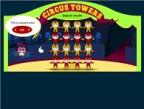In a circus context, in which acrobats make human towers of different shapes, students are introduced to number patterns arising from spatial patterns.
Teacher notes
- Students predict how many acrobats are needed to form specific shaped human towers.
- Students build up a table of data, which is also displayed as a graph.
- Students identify and describe the relationship between different representations of spatial patterns as patterns of numbers; in tables; as graphs; in words and using symbols in mathematical formulae.
- Students are assisted to develop multiplicative and algebraic formulae, and can progress to more complicated patterns, where formulae are presented and used.
- Students are introduced to non-linear graphs arising from figurate numbers such as triangular and square numbers, and prisms and pyramids with triangular and square bases.
Learning objects
 |
Circus towers: square stacks |